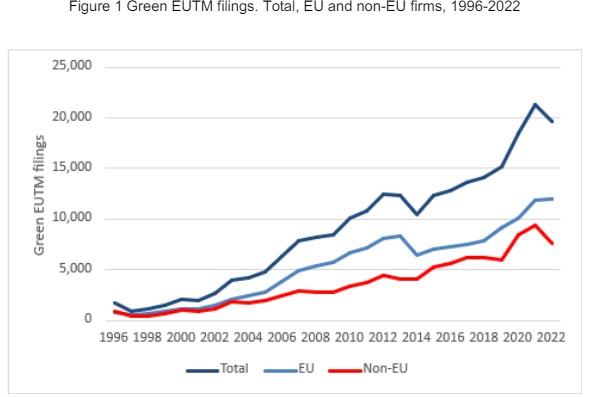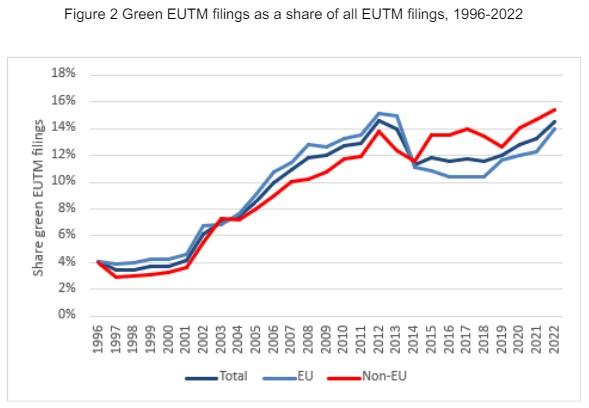Today (5 June) is the World Environment Day. The purpose of the World Environment Day is to raise awareness and generate political momentum around issues such as toxic chemicals, desertification, deforestation, and global warming. A recent study by the European Union Intellectual Property Office (EUIPO) offers intriguing insights into “green” trademarks. Turns out that trademark filings reveal a lot about sustainability trends.
The study analyzed over two million European Union Trade Mark (EUTM) applications filed between 1996 and 2021, looking for terms within product and service descriptions that indicate a focus on environmental protection and sustainable practices.
The findings suggest a growing interest in sustainability among businesses and consumers alike. Since 1996, there’s been a marked increase in “green” EUTM filings, not just in total numbers, but also as a percentage of all EUTM applications. This growth was particularly strong in 2021, suggesting an accelerating interest in eco-conscious products and services. 2022 saw a slight decline in green trademark filings, particularly originating from non-EU countries.
Source: EUIPO
Source: EUIPO
Green categories
The study categorized green trademarks into nine major category groups. Below are the categories and their share of the green trademark filings.
Energy conservation (25%)
Energy production (18%)
Transportation (15%)
Pollution control (14)
Climate change (8%)
Reusable goods (8%)
Environmental awareness (5%)
Waste management (5%)
Agriculture (2%)
A trademark is considered a “green” trademark if the list of goods/services contains at least one term (product) identified as a “green term”. The list of green terms includes approximately 900 individual terms in 35 different trademark classes. They included terms such as “Purifying chemicals (Water- -)” (class 1) and “Treatment of waste materials” in class 40.
Who’s Leading the Charge?
While large companies are significant players in the green trademark landscape, the study revealed that small and medium-sized enterprises (SMEs) are also actively contributing to the EU’s green transition. In fact, SMEs filed a higher number of green EUTMs compared to large companies, demonstrating their crucial role in driving sustainable innovation within the EU.
The study also looked at geographical trends. While the majority of green EUTM filings originate from EU member states, applications from countries outside the EU, particularly China, have also risen significantly. This underscores the global nature of the sustainability movement and highlights China’s increasing focus on green technologies and practices.
In Europe, Germany is the leading country in terms of green trademarks in absolute numbers, accounting for over 20% of green trademark filings emanating from the EU countries.
The top 5 EU countries in terms of having the largest share of green trademark filings are the following:
Slovenia (SI) – 19.8%
Spain (ES) – 19.0%
Germany (DE) – 17.0%
Finland (FI) – 16.7%
France (FR) – 16.4%
Out of all countries, Switzerland has the highest portion of green trademarks, 21.6%.
Conclusion
The EUIPO study offers a unique lens through which to view evolving sustainability trends, showcasing how trademark filing data can serve as a valuable indicator of innovation, alongside traditional metrics like patents. As the world grapples with environmental challenges, this EU study provides an encouraging glimpse into the expanding efforts of businesses to embrace and promote sustainability.
Read more
EUIPO’s report
2023 trademark round-up




